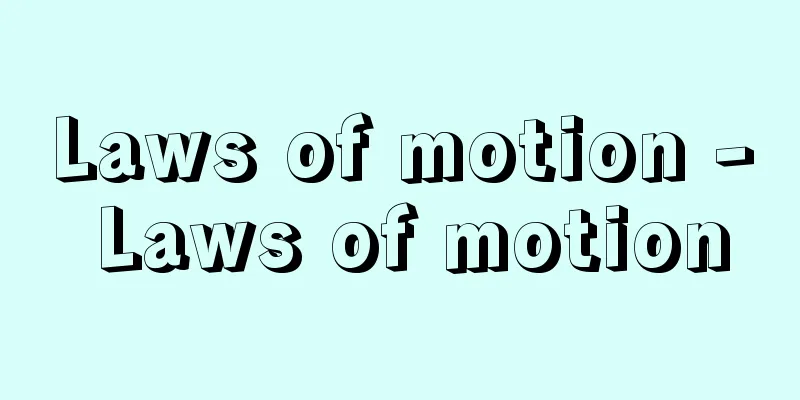Laws of motion - Laws of motion

|
These are the three laws that Newton discovered about the motion of objects, and are also called Newton's laws of motion. Motion in general involves more than just the change in the position of an object, but when talking about the laws of motion, Newton's laws of motion are usually what is meant. [Hajime Tanaka] Understanding the motion of objects – before NewtonIn the Middle Ages, it was common to discuss the motion of celestial and terrestrial objects based only on the Bible and Aristotle's physical science. As a result, it was believed that the earth was motionless and celestial bodies moved, that their motion was circular, and that terrestrial objects moved only when they were subjected to some kind of force. In contrast to this, Tycho Brahe believed that the laws of the motion of celestial bodies should be discovered through precise observation, and he made a huge amount of observations. It was Kepler who skillfully organized the observational data with his high mathematical ability and summarized them into the so-called Kepler's three laws. Galileo, relying solely on observed facts, also applied logical considerations to the laws of motion of objects, proving that objects move inertially when not acted upon by a force, and discovered the laws of motion for projectiles. However, Galileo was still subject to previous prejudices about the motion of objects, for example, he considered inertial motion to be circular motion, and not necessarily linear motion. He also lacked an understanding of gravity, and perceived falling motion as natural motion. In contrast, Newton discovered the law of universal gravitation as the cause of this motion from Kepler's laws, and perceived falling motion as accelerated motion caused by the action of gravity. He further demonstrated that inertial motion is linear motion, and summarized the laws of motion into three laws, from which many conclusions were derived. [Hajime Tanaka] The First, Second, and Third Laws of MotionNewton's laws of motion consist of three laws, which are called the first, second, and third laws of motion. First Law Every object will continue in its state of rest, or in uniform motion in a straight line, unless altered by an external force. Second Law: The change in momentum (motion) over time is proportional to the external force (motive force) applied, and occurs in the direction of the force. The terms in parentheses are those used by Newton. Third Law: The action between two objects is always equal and opposite. The second law can be written in the form of a differential equation as dp / dt = F. Here, p is the momentum of the object, and F is the external force acting on the object. Momentum is the product of the object's mass m and its velocity v , and when the mass does not change due to the motion, it takes the form m ( dv / dt ) = F. dv / dt is the acceleration a (rate of change of velocity), and using the object's position vector r , v = dr / dt , a = dv / dt = d 2 r / dt 2 The three laws of motion are closely related to each other, but each law has its own independent content. The first law (law of inertia) shows the existence of a coordinate system in which an object without the action of an external force appears to move at a constant speed, i.e., an inertial system. Before Newton, it was often thought that an object would remain stationary or continue to move in a circle unless acted upon by some kind of force. In contrast to an inertial system, a coordinate system that moves at a constant speed is also an inertial system, but as far as the first law shows, it is not necessarily the case that the rate of time progresses in both coordinate systems is the same. The second law (law of motion) shows that the rate of change of momentum or the rate of change of velocity is given by an external force, so real motion cannot be uniquely determined from this law alone. In order to determine real motion, in addition to the position of an object at any time, the velocity at the same time (or the velocity or position at a different time) must be given. The second law only applies in inertial systems in which the first law shows its existence, and the second law requires that the same form of equation of motion applies to all inertial systems under a common time. The second law seems to include the first law as a special case in which there is no external force, but this should be seen as showing that the two laws do not contradict each other. The third law (law of action and reaction) indicates that the motion of an object is separated into two independent motions: the motion of the center of gravity and the relative motion between each part. When an arbitrary object is divided into two parts A and B by its cross section, if the magnitude of the action from A to B is greater than the reaction from B to A, the object will accelerate in the direction from B to A (motion of the center of gravity) even though it is not subjected to an external force. In reality, because the magnitudes of the action and reaction are equal and opposite, these actions and reactions do not affect the motion of the center of gravity of the entire object. [Hajime Tanaka] [References] | | | | |Source: Shogakukan Encyclopedia Nipponica About Encyclopedia Nipponica Information | Legend |
|
物体の運動についてニュートンが発見した三つの法則のことで、ニュートンの運動法則ともいう。運動一般のなかには、単に物体の位置の変化に限らずそれ以外のものがあるが、運動の法則といえば通常ニュートンの運動法則を意味する。 [田中 一] 物体の運動のとらえ方――ニュートン以前中世にあっては、聖書とアリストテレスの自然学にのみ基づいて天体と地上の物体の運動を論ずるのが普通であった。その結果、大地は不動であって天体が運行し、その運動は円環的で、かつ地上の物体はそれがなんらかの力を受けているときにのみ運動していると考えられていた。これに対して、天体の運行の法則をその精密な観測のもとにみいだすべきであると考え、膨大な量の観測を行ったのがティコ・ブラーエで、その観測データを高い数学的能力によって巧みに整理し、いわゆるケプラーの三法則にまとめたのがケプラーである。 ガリレイもまた、観察された事実にのみよりどころを求めながら物体の運動法則に論理的考察を加えて、物体が力の作用を受けないときには慣性運動を行うことを論証し、また放物体の運動の法則をみいだした。しかし、ガリレイはまだそれまでの物体の運動に関する偏見のとりこになっていた点もあって、たとえば慣性運動を円運動とみて、かならずしも直線運動とは考えなかった。また重力についての認識も欠いており、落下運動を自然運動と受け取った。これに対してニュートンは、ケプラーの法則からこの運動をもたらすものとして万有引力を発見し、落下運動も引力の作用によって生じた加速度運動としてとらえた。さらに、慣性運動が直線運動であることを示し、運動の法則を3法則にまとめ、これから多くの結論を引き出した。 [田中 一] 運動の第一、第二、第三法則ニュートンの運動法則は三つの法則から成り立っており、それぞれ運動の第一、第二、第三法則とよぶ。 第一法則 すべての物体は、その静止の状態を、あるいは直線上の一様な運動の状態を、外力によってその状態を変えられない限り、そのまま続ける。 第二法則 運動量(運動)の時間的変化(変化)は及ぼされる外力(起動力)に比例し、その力の及ぼされる方向に行われる。括弧(かっこ)内はニュートンの用いた用語である。 第三法則 2物体相互の作用は、つねに相等しく逆向きである。 第二法則を微分方程式の形で書き表せば、dp/dt=Fとなる。ここでpは物体の運動量、Fは物体に作用する外力である。運動量は物体の質量mとその速度vの積であって、質量が運動により変化しない場合にはm(dv/dt)=Fの形をとる。dv/dtは加速度a(速度の変化率)であって、物体の位置ベクトルrを用いて 運動の三法則の間には互いに密接な関係があるが、各法則はそれぞれ独立な内容を有している。第一法則(慣性の法則)は、外力の作用を受けない物体が等速度で運動するようにみえる座標系、すなわち慣性系の存在を示す。ニュートン以前には、物体がなんらかの作用を受けない限り、静止するかあるいは円運動を続けるものと考えられることが多かった。慣性系に対し、一定の速度で動く座標系も同じく慣性系であるが、第一法則の示す限りでは、かならずしも両座標系の時間の進み方が同じでなければならないということはない。 第二法則(運動の法則)は、運動量の変化の割合あるいは速度の変化の割合が外力によって与えられることを示すものであるから、この法則だけからは現実の運動は一義的に定まらない。現実の運動を定めるためには、任意の時刻の物体の位置のほかに、同時刻の速度(あるいは異なる時刻の速度か位置でもよい)を与えなければならない。第二法則が成り立つのは、第一法則がその存在を示した慣性系においてのみであって、第二法則はすべての慣性系に対して共通の時間のもとに同一形式の運動方程式の成り立つことを要請している。外力のない特別の場合として第二法則は第一法則を含んでいるようにみえるが、このことは、両法則が互いに矛盾しないことを示すものとみるべきであろう。 第三法則(作用・反作用の法則)は、物体の運動が重心運動と各部分間の相対運動という独立な二つの運動に分離することを示す。任意の物体を断面によって二つの部分A、Bに分けたとき、もし、AからBへの作用の大きさよりもBからAへの反作用が大きいとすれば、外力の作用を受けていないにもかかわらず、この物体はBからAの方向に加速度運動を行う(重心運動)。実際には、作用と反作用との大きさが等しく方向が反対のため、これらの作用・反作用は物体全体の重心運動に影響をもたらさない。 [田中 一] [参照項目] | | | | |出典 小学館 日本大百科全書(ニッポニカ)日本大百科全書(ニッポニカ)について 情報 | 凡例 |
<<: Exercise folds - Exercise folds
Recommend
Stories from the fairyland
A Shinto book by Hirata Atsutane. Also known as &q...
tree pipit
...It mainly eats insects while walking on the gr...
Stevens, S.
...The conflict between the north and south, repr...
Cotopaxi [Mountain] - Cotopaxi
A volcano in the eastern Andes Mountains in South ...
Terebra areolata (English spelling)
…[Tadashige Nabe]. . … *Some of the terminology t...
Apeltonotus dorsalis
...In addition to this species, the Amur grass li...
Metal poisoning
...Health problems caused by chemical substances ...
Arcus, W. von - Arcus
…A type of current meter for measuring ocean curr...
Modern state - Kindai Kokka (English spelling) modern state
Generally speaking, it refers to the nation-state...
Scutellaria root - Scutellaria root
…It is cultivated in Hiroshima, Kanagawa, Shizuok...
Guitry, L. (English spelling) GuitryL
...His father, Lucien Guitry (1860-1925), was a F...
Yahya Kemal
1884‐1958 Turkish poet. Born in Üsküp (now Skopje,...
Avancini, N.
…The Jesuit drama in the German-speaking world, w...
Kawasaki Sadataka
Year of death: 6th June 1767 (1st July 1767) Year ...
Yuji Aida
1916-1997 A Western history scholar and critic fr...









